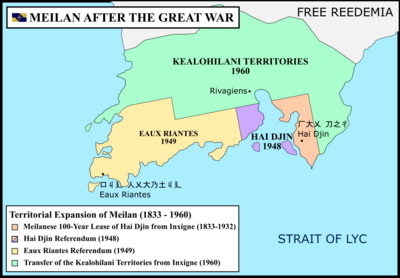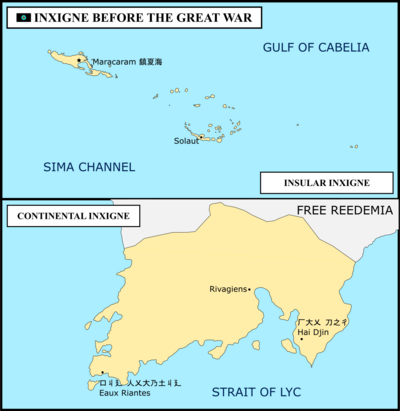Inxigne

|
Inxigne Etsatse v'Inxigne (Inxignese Patois) Capital: Maracaram
Population: 110,845 (2010) |
Loading map... |
Inxigne (Ingerish: (ink-sine)); Valonian: Inxigne /ɛ̃ksiɲ/ [1] is an island country in the Rivages of Tarephia in free association with Tigeria. Across the Cabelian Gulf to the north is Airannia, and across the Sima Channel to the south is AN127. Inxigne shares a maritime border with TA113b. The capital and largest city in Inxigne is Maracaram.
Home to centers such as the Strait of Lyc Fisheries Institute and to the Sima Channel and Vistaram Islands Marine Sanctuaries, Inxigne contributes valuable data and insights to environmental sustainability research.
Tigeria is responsible for Inxigne's defense and certain foreign affairs, but they are exercised in consultation with Inxigne. Although Inxignese are citizens of Tigeria, they have the status of Inxigne nationals, which is not given to other Tigerine citizens.
Etymology
Inxigne means "island nation" from inx (island) and -igne which means "the land of". The modern Valonian equivalent is Îlie. Inxigne is derived from old Rivagine "insulae", insula (island) and -ae (the land of).
History
Baveili Discovery
The islands of Inxigne were inhabited by the Inxignese when the Baveilis arrived. The earliest written records of Inxigne recount the Baveilis' landing on Inxigne. Meilanese historian Leontin Shin He is credited with giving the Inxignese island groups their names during his commissioned exploration for Florescenta:
- ...vistaram as ilhas orientais três dias depois...no dia seguinte, doze navios passaram pelo arquipélago e treze navios restaram...nas ilhas ocidentais marcharam para a praia e acamparam...
Thus to the world, the eastern islands became known as the Vistaram Islands, the archipelago became known as the Passaram Archipelago, and the city which the Baveilis founded became known as Maracaram.
Inxignese Trade Empire and Valonian Arrival (1200-1450)
Maracaram quickly became the center of the Inxignese trade network that extended from Tigeria to Meilan. Inxignese merchants were shipping goods for others within the network, and their maritime knowledge of the region became widespread. With the arrival of the Valonian, who called the region the pays-rivages, the Inxignese's influence on maritime trade expanded further.
Goxianese Thalassocracy (1450-1750)
In the east, the Meilanese began to capture a greater share of the maritime trade network. At the same time, the presence of other merchants attracted the attention of the several other nations to the Rivages. During this time, Valonian and Meilanese migrants established the cities of Eaux Riantes and Hai Djin on Inxignese territory in what is now today Meilan. By the nineteenth century, politicians in Maracaram frequently complained that the mainland had too much power, and the government looked for ways to consolidate power in Maracaram. As a consequence, Inxigne decided to implement a one-hundred year lease of Hai Djin to Meilan to increase revenues.
Present Day (1940 - Today)

The dissolution of Meilan following the great war presented a political question to Inxigne. Many Meilanese had fled to Hai Djin and Eaux Riantes and had no representation in the Inxignese government. Furthermore, the Hai Djin lease no longer was in force.

The Assembly of Nations, wishing to maintain peace in the area, worked with the Inxignese government on several solutions. Concerned again about another shift of political power to the Tarephian mainland, the Inxignese government presented a series of questions to the Inxignese nation to decide what action to take on Hai Djin and Eaux Riantes:
- Reintegration of Hai Djin into Inxigne
- Administration of Eaux Riantes and Hai Djin as special territories of Inxigne
- Separation of Eaux Riantes and Hai Djin for the Meilanese people
While the people in Eaux Riantes and Hai Djin voted to integrate Hai Djin into Inxigne, the people in Inxigne voted to separate Eaux Riantes and Hai Djin for Meilan. The Assembly of Nations also passed a resolution recognizing the right of the Meilanese people to self-determination. With the Inxignese government refusing to integrate Hai Djin into Inxigne, Eaux Riantes and Hai Djin became the new territory of Meilan. Inxigne and Meilan remained close relations as Inxigne supported Meilan by providing its natural resources.
During this time, the Assembly of Nations worked to provide Meilan with the resources it needed for greater self-sufficiency. In this process, the Assembly of Nations negotiated with Inxigne to transfer to Meilan what are today the Kealohilani Territories.
Inxignese diplomat and politician Kai Kealohilani would represent Inxigne before the Assembly of Nations as Tigeria's ambassador to the Assembly of Nations. Kealohiliani would later serve as Secretary General of the Assembly of Nations where he is best known for resolving several global political questions following the Great War. One of his most recognized accomplishments is his administration's establishment of the mandate for Meilan, which continues to impact the Lycene region today.
Geography, Climate, and Environment
The islands of Inxigne can be divided into two groups:
- The Vachionu Islands (Grand Vachionu and Petit Vachionu)
- The Passaram Islands (Passaram Archipelago and Vistaram Islands)
Demographics
The Inxignese are indigenous to the islands of Inxigne. Many Inxignese are fishers and farmers by trade, and the Inxignese are regarded as one of the peoples that are the most knowledgeable about Lycene waters. Inxignese people acquired a wealth of knowledgeable about shipbuilding since they frequently traveled along their trade routes for centuries. Today, many young Inxignese students can be found on ships learning the fundamentals of shipbuilding and maritime navigation.
Many ethnic Airannians live in the Nitrefoix District in Maracaram Magister, where they fish in the Cabelian Gulf.
Culture

Inxignese's way of life can be described as "anti-fancquerie," the renunciation of the elements of urban life. Inxignese society is built around the community, and cities and towns often have communal buildings and houses.
Cuisine
Inxignese cuisine is influenced by the land and the sea. It incorporates the fruit of the land, the fish of the sea, and the food of the Inxignese trade routes from other regions of the world.





